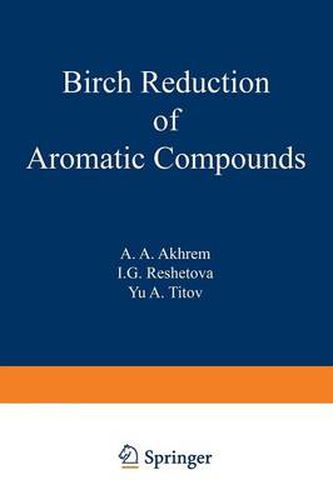Readings Newsletter
Become a Readings Member to make your shopping experience even easier.
Sign in or sign up for free!
You’re not far away from qualifying for FREE standard shipping within Australia
You’ve qualified for FREE standard shipping within Australia
The cart is loading…






This title is printed to order. This book may have been self-published. If so, we cannot guarantee the quality of the content. In the main most books will have gone through the editing process however some may not. We therefore suggest that you be aware of this before ordering this book. If in doubt check either the author or publisher’s details as we are unable to accept any returns unless they are faulty. Please contact us if you have any questions.
Birch reduction (see reviews [1-5]) is the name given to the reaction of unsaturated organic compounds with alkali metals and alcohols in liquid am monia. This method was first used for aromatic compounds in 1937 by Wooster [6J, who showed that benzene and its derivatives are reduced by sodium in liq uid ammonia in the presence of an alcohol, while this reaction does not take place in the absence of an alcohol. However, the general recognition and broad application of this reaction was achieved only after a series of investigations by Birch published from 1944 onwards [7J. Since the presence of an alcohol in the reaction medium is not indispen sable for pOlycyclic aromatic systems, the present review includes only deriv atives of the simplest aromatic compounds - benzene and naphthalene. 1 Reaction Mechanism The most probable mechanism of Birch reduction, adopted by the major ity of workers in this field [4, 8 -12] can be represented by the following stages: ‘v\ I NH -’ ,. - i T 1 3 +– ‘( a) , , ,e (NHa) NH 3) + ROH —-+ () ll. . (NHa) A H H 4) H H 5) ’)‘, ,,\+ + RO ~ Q + 110M,,,,,, / (NHa) . (NH:,) Q H H Ii Ij H H H H H+ X/~H M,l
$9.00 standard shipping within Australia
FREE standard shipping within Australia for orders over $100.00
Express & International shipping calculated at checkout
This title is printed to order. This book may have been self-published. If so, we cannot guarantee the quality of the content. In the main most books will have gone through the editing process however some may not. We therefore suggest that you be aware of this before ordering this book. If in doubt check either the author or publisher’s details as we are unable to accept any returns unless they are faulty. Please contact us if you have any questions.
Birch reduction (see reviews [1-5]) is the name given to the reaction of unsaturated organic compounds with alkali metals and alcohols in liquid am monia. This method was first used for aromatic compounds in 1937 by Wooster [6J, who showed that benzene and its derivatives are reduced by sodium in liq uid ammonia in the presence of an alcohol, while this reaction does not take place in the absence of an alcohol. However, the general recognition and broad application of this reaction was achieved only after a series of investigations by Birch published from 1944 onwards [7J. Since the presence of an alcohol in the reaction medium is not indispen sable for pOlycyclic aromatic systems, the present review includes only deriv atives of the simplest aromatic compounds - benzene and naphthalene. 1 Reaction Mechanism The most probable mechanism of Birch reduction, adopted by the major ity of workers in this field [4, 8 -12] can be represented by the following stages: ‘v\ I NH -’ ,. - i T 1 3 +– ‘( a) , , ,e (NHa) NH 3) + ROH —-+ () ll. . (NHa) A H H 4) H H 5) ’)‘, ,,\+ + RO ~ Q + 110M,,,,,, / (NHa) . (NH:,) Q H H Ii Ij H H H H H+ X/~H M,l